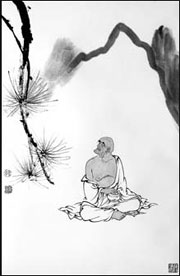Commemorating the lives of wise guys
Sakyamuni, the founder of Buddhism, told his disciples - the arhats - to stay in the earthly world and enlighten the masses. Xuanzang, a Tang Dynasty (AD 618-907) monk, brought many Buddhist classics home from his travels throughout India and helped further spread the stories of the 16 arhats.
|
Uncontaminated, by Han Xuanzhen. |
The number of arhats increased with the spread of Buddhism, which first entered China in the Han Dynasty (206 BC-AD 220). By the Five Dynasties (AD 907-960), legends about 500 arhats had become popular. Many paintings and sculptures were devoted to the various tales about them, and this led to the creation of a special art genre in China.
At the Qiongzhu Temple in Kunming, Southwest China's Yunnan Province, one of the depicted arhats has an extremely long arm reaching towards a moon carved on the 5-meter-tall ceiling of the spacious hall; another has silver-white eyebrows that dangle from his forehead to his feet.
The Biyun Temple in Beijing, Baoguang Temple in Chengdu, in Southwest China's Sichuan Province, Xiyuan Temple, in Suzhou in East China's Jiangsu Province, Guiyuan Temple in Hanyang, Central China's Hubei Province, and Qiongzhu Temple in Kunming are the most famous for homes of arhat sculptures.
China Daily
(China Daily 11/06/2007 page20)















